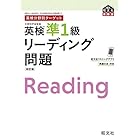英検®準1級長文読解のコツ3つを解説!高得点を狙う勉強法と練習問題

【英検®準1級の長文読解対策】「問題が解けない」「時間が足りない」そんな悩みを解決!この記事では、長文問題の概要から効果的な勉強法、実践的な練習問題と解説までを網羅。合格をぐっと引き寄せるコツを、具体的なステップで解説します。

■この記事を書いた人
純ジャパながら独学で英検®1級、TOEIC®925を取得。年間300人以上に指導している現役英会話講師です。字幕・吹替・広告翻訳家としての顔も持ち、現在は1児の母として子育てと両立しながらフランス語も話すマルチリンガルに。メディア会社での役職経験を活かした分かりやすい解説で、英語学習に役立つコンテンツをお届けしています。
英検®準1級長文読解問題の概要と出題傾向
まずは、英検®準1級の長文読解問題の傾向について知っておきましょう。
英検®準1級長文読解の概要
英検®準1級の長文読解問題は、一次試験(筆記)の大問2と大問3で出題され、大問2は空所補充、大問3は内容一致が中心です。科学、歴史、文化、社会問題、環境問題など、幅広い分野から出題されます。専門的な内容も含まれますが、文脈から推測できる程度の難易度です。また、本文中に固有名詞や具体例などが含まれることが多いですが、専門知識を持っている必要はなく、英語力があれば解くことができる問題となっています。
英検®準1級長文読解の設問の特徴
設問の種類には、主に4種類あります。
- 内容理解
本文の内容に合致する選択肢を選ぶ問題で、英検®準1級の読解問題のほとんどが内容理解を問うものになっています。 - 推論
本文には直接書かれていないが、本文の情報から論理的に導き出せる結論を問う問題も出題されます。 - 筆者の意図/主張
筆者が何を伝えたいのか、その意図や主張を問う問題も頻出です。 - 語彙・表現
文脈から語句の意味を推測する問題もまれに出題されます。
| 【関連記事】 📖3か月で英検®準1級に受かるには?|英検®1級講師が解説 |
英検®準1級長文読解で高得点を取る3つのコツ
ここからは、英検®準1級長文読解で高得点を取る3つのコツを見ていきましょう。
コツ① 設問の根拠を見つけよう
英検®準1級の長文読解の問題では、必ず選択肢のヒントが本文中にあります。どこに選択肢を選ぶ根拠があるのか確認しましょう。根拠を見つける力があることで効率良く問題を解くことができるので本番で役に立ち、自信を持って選択肢を選ぶことができます。
コツ② 複雑な文は精読しよう
精読とは、文の構造を一つずつ丁寧に確認しながら読み解くことです。主語はどれで、動詞はどこか、といった具合に文構造への理解を深め、英文をより深く理解することができます。一度読んだだけでは分からなかった文も、ゆっくりと整理しながら読むことで意味を理解することができます。
コツ③ 語彙力を徹底的に強化する
読んでわからない単語は、問題を読んでいる時は文脈から推測する習慣をつけつつ、後で必ず調べるようにしましょう。中でも、英検®準1級レベルの単語は覚える必要があります。単語帳の索引で調べ、載っているものは覚えましょう。
| 【こちらの記事も読まれています】 📖英検®準1級おすすめの単語帳3選!勉強法も解説|英検®1級の英会話講師がレクチャー |
【練習問題】The Rise of Urban Farming
実際に練習問題を解いてみましょう。
The Rise of Urban Farming
Urban farming, the practice of cultivating, processing, and distributing food in or around urban areas, is a growing global trend. While not a new concept—historical records show that ancient civilizations engaged in some form of urban agriculture—its modern resurgence is driven by a confluence of factors.
One primary driver is the increasing concern over food security and the environmental impact of industrial agriculture. By growing food locally, urban farms reduce the carbon footprint associated with long-distance transportation and decrease reliance on monocultures, which can be vulnerable to disease.
Another key advantage of urban farming is its social and educational benefits. Community gardens, for example, often serve as vibrant social hubs, fostering a sense of community among residents. They provide opportunities for people to learn about sustainable practices, nutrition, and food production. This direct connection to the food system can lead to healthier eating habits and a greater appreciation for the resources required to produce food. Moreover, urban farming can transform neglected urban spaces, such as rooftops, empty lots, and even abandoned warehouses, into productive green spaces. These green spaces can mitigate the “urban heat island effect” by providing shade and releasing moisture into the air.
However, urban farming is not without its challenges. One significant hurdle is the limited availability of space. Many urban areas are densely populated, making it difficult to find suitable land for large-scale cultivation. Additionally, soil contamination is a major concern in some urban environments, as heavy metals and other pollutants can accumulate in the soil. Urban farmers must therefore invest in costly soil testing or use alternative methods like hydroponics or vertical farming.
Despite these challenges, the future of urban farming looks promising. As technology advances and cities become more committed to sustainable development, urban agriculture is poised to play an increasingly important role in creating healthier, more resilient, and more equitable food systems.
【設問】に挑戦しよう
(1) According to the passage, which of the following is a primary reason for the recent increase in urban farming?
- A renewed interest in ancient agricultural techniques.
- The widespread availability of new agricultural technologies like hydroponics.
- Growing concerns about global food transportation and its environmental effects.
- A desire to create more social hubs and community spaces in cities.
(2) Which of the following is a challenge faced by urban farmers?
- The high cost of seeds and equipment.
- Difficulty in finding enough skilled labor.
- The risk of soil being contaminated by pollutants.
- Lack of interest from local communities.
(3) What can be inferred about the future of urban farming from the passage?
- It is unlikely to become a major food source due to space limitations.
- It will become more widespread as cities focus on sustainable development.
- It will require a return to traditional, land-intensive farming methods.
- It will primarily benefit affluent communities with access to green spaces.
【解答解説】
(1) 正解は 3
解説: 本文の第1段落に、「One primary driver is the increasing concern over food security and the environmental impact of industrial agriculture. By growing food locally, urban farms reduce the carbon footprint associated with long-distance transportation…」とあります。これは、食料の輸送が環境に与える影響への懸念が、都市型農業の主な推進要因であることを示しています。
- 1は本文では古代の都市型農業に言及していますが、それが「最近の増加の主要な理由」とは述べていません。
- 2はハイドロポニックスなどの技術が言及されていますが、これは課題の解決策であり、増加の主要な理由ではありません。
- 4は社会的・教育的利益の一つですが、本文ではこれを主要な推進要因とはしていません。
(2) 正解は 3
解説: 本文の第3段落に、「soil contamination is a major concern in some urban environments, as heavy metals and other pollutants can accumulate in the soil.」とあります。都市の土壌が汚染されている可能性があることが、都市型農業が直面する大きな課題として挙げられています。1, 2, 4は本文で直接言及されていません。
(3) 正解は 2
解説: 本文の最終文に、「As technology advances and cities become more committed to sustainable development, urban agriculture is poised to play an increasingly important role…」とあります。これは、都市が持続可能な開発に力を入れるようになるにつれて、都市型農業がより重要な役割を果たすだろうという推論を可能にします。
- 1は、本文の「the future of urban farming looks promising」という記述と矛盾します。
- 3は本文に記載されていません。本文では、ハイドロポニックスや垂直農法といった新しい技術についても言及しています。
- 4は本文には記載がなく、推論もできません。本文はコミュニティ全体への利益について述べています。
英検®準1級長文読解の正答率を上げる勉強法
長文読解の問題を解きっぱなしでは、読む力はついていきません。しっかりと本文や設問を見直して復習をしましょう。今回は、効果的な勉強方法を紹介します。
設問の根拠を見つける練習をしよう
英検®準1級の長文読解の問題では、必ず選択肢のヒントが本文中にあります。どこに選択肢を選ぶ根拠があるのか本文中の文に線を引くなどして練習しましょう。根拠を見つける力があることで効率良く問題を解くことができるので本番で役に立ち、自信を持って選択肢を選ぶことができます。
おすすめの問題集
 | 2025年度版 英検準1級 過去6回全問題集(音声DL付) 2025年度版 英検過去6回全問題集シリーズ 新品価格 |
実際に出題された過去問を使って練習することで問題傾向をつかむことができます。解答解説が詳しく載っている旺文社の過去問がおすすめです。
精読と多読を繰り返そう
精読とは、文の構造を一つずつ丁寧に確認しながら読み解くことです。主語はどれで、動詞はどこか、といった具合に文構造への理解を深め、英文をより深く理解することができます。文単体で理解できたら、最初から最後まで通して読み直してみましょう。ストーリーがどのように展開しているのか確認し、文章全体の流れを理解しましょう。
その一方で多読とは、たくさん読むことです。さまざまな長文を読み、精読なしでも文を英語のまま理解できるようになることが目標です。しっかりと丁寧な学習を続けることで、少しずつ力がついていきます。
おすすめの問題集
 | 新品価格 |
41個の長文が収録されている問題集です。英検®対策書売上No.1の旺文社が出版している信頼できる1冊です。過去問をひと通り終えたけど物足りない、とにかく量をこなしたいという人にピッタリの教材です。
単語や熟語、文法知識を身につけよう
まずは、単語や熟語、文法知識といった基礎をしっかりと身につけましょう。読んでわからない単語は、問題を読んでいる時は文脈から推測する習慣をつけつつ、後で必ず調べるようにしましょう。中でも、英検®準1級レベルの単語は覚える必要があります。単語帳の索引で調べ、載っているものは覚えましょう。単語が分かったうえで読んでも分からない文は、文法の理解ができていない可能性があります。どの文法が使われているのか、文構造はどうなっているのか確認しましょう。
おすすめの単語帳
 | 【音声アプリ対応】英検準1級 でる順パス単 5訂版 (旺文社英検書) 新品価格 |
「でる順パス単」は、英検®対策に定番の1冊です。この単語帳さえやっておけば安心というくらい英検®準1級に出てくる単語帳を網羅しています。単語だけでなく熟語や会話表現も収録しているのが嬉しいポイント。
旺文社の音声アプリ「英語の友」をダウンロードすれば無料で音声を聞くことができます。正しい発音をチェックしながら単語を覚えることができるため質の高い対策ができる点はかなり魅力的です。
英検®準1級長文読解は「量」と「質」のバランスが鍵
英検®準1級の長文読解は、決して一朝一夕で身につくものではありません。学び始めの時は、単語量や文法の理解が甘く、なかなか長文を理解できずに苦しいかもしれませんが、少しずつ続けていけば読解力を伸ばすことができるはずです。孤独な学習になるので、勉強仲間を見つけたり、合格へと導いてくれるレッスンを受講することをおすすめします。
英検®準1級に本気で合格したい人はこちら
meantのオンライン英会話では、これまで英検®合格者を多数輩出してきた英検®1級講師が指導。年間300人以上が受講している人気講師で、「説明が分かりやすい」「穏やかな雰囲気で質問しやすい」と大好評です。
講師は「合格しました!」の声をいただく度に自分のことのようにうれしく感じています。一人ひとりの生徒様の目標や英語力に合ったペースで伴走してくれるので、とても心強いですよ。次は、あなたが合格する番です!まずは気軽にお申し込みください。



